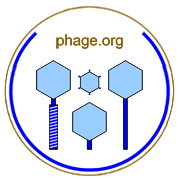

Chapter authored by Laurence D. Goodridge published in 2008 with appendix by Stephen T. Abedon.
Goodridge, L. D. 2008. Phages, bacteria, and food, p. 302-331. In: S. T. Abedon (ed.), Bacteriophage Ecology. Cambridge University Press, Cambridge, UK. [Google Books]
Abstract: Bacteriophages have been observed to occupy virtually every ecological niche, and it should be no surprise that they are naturally present in food. While most phage-host interactions in food are inferred, but not routinely or knowingly observed, the phage-mediated destruction of starter cultures during fermentation of dairy products is a potent reminder of the ability of bacterial viruses to alter the microbial ecology of food. Alternatively, in recent years researchers have developed applied uses of bacteriophages, especially to solve agricultural problems. For example, bacteriophages have been proposed as indicators of possible viral and fecal contamination of food, while the ability of lytic bacteriophages to infect and kill their hosts has been exploited in the biocontrol of foodborne pathogenic and spoilage bacteria. Other workers have developed phage-based methods to rapidly detect bacterial pathogens. Most of these methods take advantage of the ability of phages to amplify themselves to large numbers during bacterial infection. Nevertheless, it is clear that several challenges must be overcome before phages will be routinely used as components of food production. These include the problem of bacterial resistance to phage infection and the need for separation of target bacteria from the food matrix during phage-mediated bacterial detection. Finally, the recent Food and Drug Administration (FDA) approval of the use of phages as antimicrobials to control bacterial growth in ready-to-eat meats is an exciting development that should lead to increased commercial interest in phage-based biocontroll of bacteria in food (i.e., phage “therapy” of food). This chapter reviews issues and technologies associated with phage–bacterial interactions in food, taking as a premise that many of these interactions may be fruitfully explored from a phage-ecological perspective.
First paragraph from Appendix: Phages may be employed to detect the presence of bacteria (Section 12.3) and/or to reduce the presence of bacteria (Section 12.4). In either process, phage adsorption to bacteria is required and increased efficacy occurs if more bacteria are adsorbed. During bacterial detection, for example, a 1000-fold increase in signal should occur if 1000-fold more bacteria are phage-adsorbed. For the sake of real-world efficacy, it also is best if those bacteria become adsorbed sooner rather than later. Similarly, for phage-based biocontrol of bacteria, the more of those 1000 bacteria that are adsorbed (and killed), the better, and it is preferable that adsorption occurs over periods that are reasonably short relative to the replication rates of the target bacteria, or the handling time of the sample.
Second paragraph from Appendix: What approaches should one take to assure that a majority of bacteria become phage-adsorbed relatively quickly? Obvious answers are to employ phages that have a reasonably high affinity for the problem bacteria, especially under the conditions encountered, and then to provide large numbers of phages. These points should be fairly obvious, but the latter can be problematic because many individuals are seemingly of the mistaken opinion that what determines likelihood of phage adsorption to a population of bacteria is the ratio of the densities of phages to bacteria (multiplicity of infection, MOI; Chapter 3). However, it is phage density alone that determines rates of phage adsorption to individual bacteria. The notion of MOI consequently can obscure one’s understanding of adsorption efficacy, as this appendix will elaborate.
Contact web master. Return to terms.











